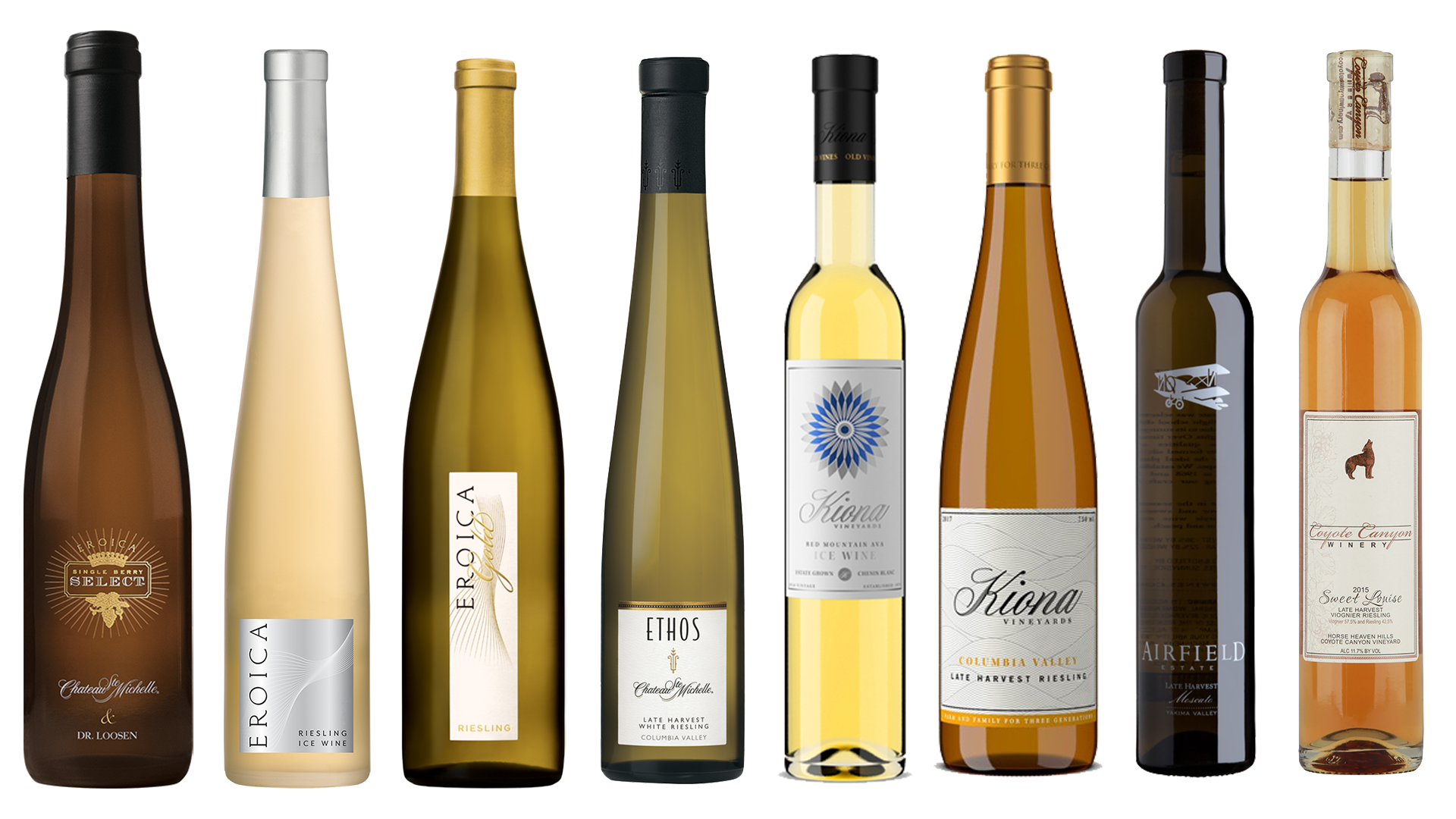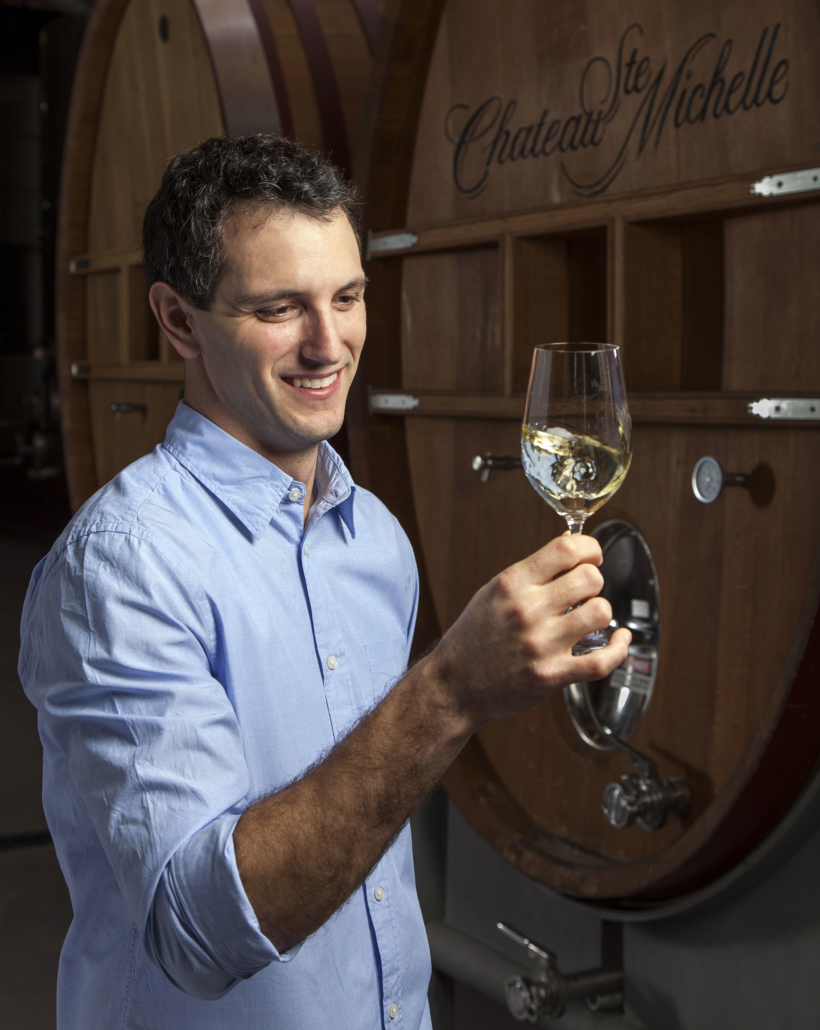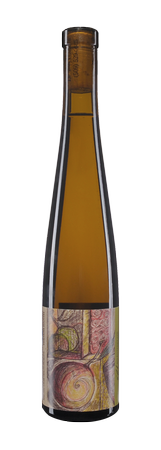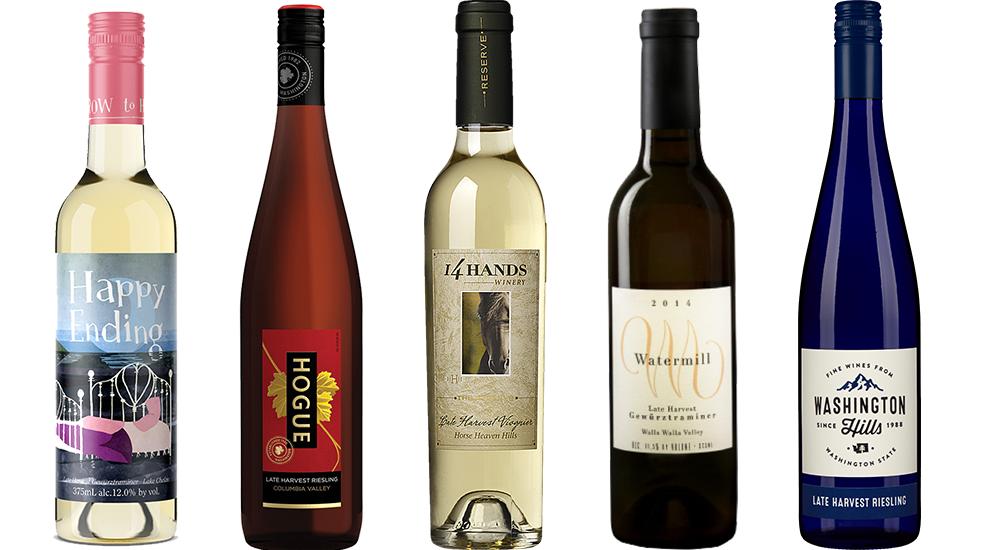Late Harvest Dessert and Ice Wines: Washington
wineries make some very good ones
Kiona Vineyards and Chateau Ste. Michelle were among first
Washington wineries to make high-quality late harvest wine
By Ken Robertson
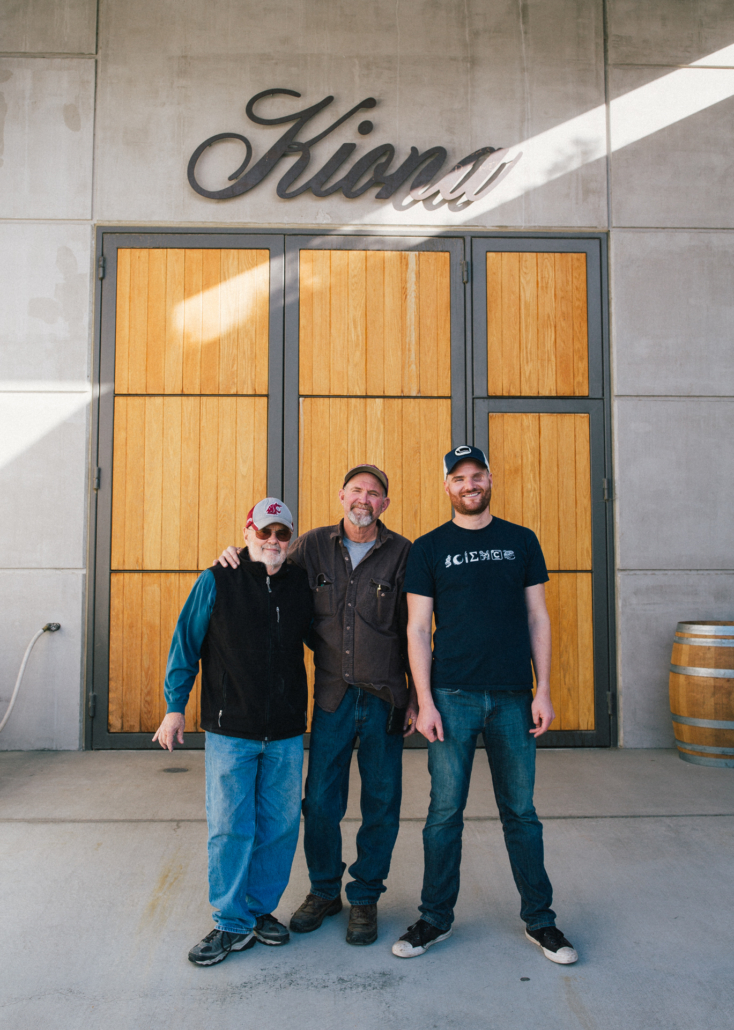
The three generations of the Williams family, from left to right: John (Kiona’s co-founder), John’s son Scott and Scott’s son J.J.
As autumn begins to turn leaves to yellow, orange and red each year, Washington winemakers and grape growers begin watching weather forecasts and visiting their vineyards, anxiously checking to see how ripe the grapes are becoming.
Most are worried about getting their grapes up to an appropriate sugar content — probably about 24 to 26 brix — before the arctic sends down a blast of frigid weather that will frost the grape leaves and end further ripening.
A hardy few of them, however, will be looking forward to the latest possible pick dates, because they make some of the state’s rarest wines: true late harvest wines and ice wines of the sort perfected long ago in Europe’s northern tier, including France, Germany and Hungary.
“They’re some of the world’s most expensive and most collectible wines,” J.J. Williams of Kiona Vineyards and Winery regularly tells visitors.
His own family — he’s the third generation to work at Kiona — arguably makes some of the Northwest’s finest dessert and ice wines. Kiona, a relatively small family operation that produces about 30,000 cases of wine annually, has a giant reputational footprint, partly because of its Red Mountain location and partly because it sells its grapes to roughly 60 other Northwest wineries, which proudly proclaim that fruit’s AVA of origin and its Kiona Vineyards heritage.
As Washington wineries have attempted to match the Europeans’ perfection, they’ve succeeded in creating worthy competition at more affordable prices, with high-quality versions often selling for $25 to $35. Best-quality ice wines and single-berry select wines from Washington typically sell for $50 to $60 for half-size bottles, which is still a fraction of the price of their German counterparts.
At Kiona, grape-growing and wine-making experimentation were underway for several years by then-partners John Williams and Jim Holmes before they went public in 1982 with their first dessert wine, a 1981 late harvest Riesling from Ciel du Cheval Vineyard. Only six years earlier, the two and their families had begun planting the very first wine grapes on Red Mountain, which has since become one of the Northwest’s and the nation’s most highly regarded American Viticultural Areas (AVAs).
At about the same time Williams and Holmes started their operation, the late Mike Wallace founded Hinzerling Winery in Prosser, assisted by his Dad, Jerry, and also began experimenting with late harvest wines, making some memorable versions from Gewürztraminer.
I vividly recall tasting one of them in the late 1970s or early 1980s at an Eastern Washington Technical Wine Tasting Society meeting at Preston Wine Cellars. Rob Griffin, now head winemaker and co-owner of his own Barnard Griffin label, at the time was the recently minted winemaker at Preston.
In evaluating a Wallace-made late harvest Gewürztrminer, Griffin notes: “Well it’s got some faults, but I wish I’d made it. I’d be happy to have a case.” Wallace eventually stopped making late harvest wines, moving on to Port-style wines years before his untimely death in 2016.
While small producers such as Kiona, Hinzerling and a few others turned out exciting dessert wines in the early years, Chateau Ste. Michelle also released its first ice wine in 1978, making it among North America’s first producers of ice wine. But 1999 changed the face of Washington’s sweet wine world forever, again because of the efforts of Chateau Ste. Michelle.
By partnering with Dr. Ernst Loosen, one of Germany’s premier winemakers, Chateau Ste. Michelle began producing a premium-level Riesling and a single berry select late harvest Riesling of the type the Germans call trochenbeerenauslese. Both were called Eroica.
The following year, the new Eroica earned a 91-point rating from Wine Spectator. But the late harvest single berry select scored the highest ever for a U.S.-produced Riesling — a rarified 97 points. That instantly installed Chateau Ste. Michelle among the ranks of the nation’s, and arguably the world’s, best dessert winemakers, a reputation that’s been burnished repeatedly by scores in the mid-90s for ensuing vintages.
David Rosenthal, head white winemaker at Ste. Michelle, now oversees the dessert wine team there, which is led by Tracey Keller. Her group is small but mighty, annually crafting a set of three to four different late harvest wines and often an ice wine, made after arctic winds drop temperatures to 17 degrees Fahrenheit or below.
Harvest for Ste. Michelle’s late harvest wines generally occurs during a three-day window at the tail end of harvest season in a select part of a Riesling block that straddles the top of the Horse Heaven Hills adjacent to Ste. Michelle’s sister winery, Columbia Crest, outside of Paterson,WA.
The northernmost that the Riesling vines stretch over the hill’s crest is an area that attracts fall morning fogs from the nearby Columbia River, and the grape clusters thus regularly become host to“noble rot,” botrytis cinerea, which, when it infects the clusters, dehydrates the grapes and shrivels them into raisins.
Once the fall days and the botrytis have worked their magic, Ste. Michelle’s crews arrive for three days of hand harvesting. On day one, crews pick clusters that are 75% or more affected with botrytis, which helps dehydrate the grapes and concentrates sugars to about 45 brix and accentuates flavors. These are made into a single-berry select wine similar to what the Germans call trochenbeerenauslese (TBA).
On day two, crews pick grapes 50-75% affected by botrytis that are about 40 brix. These are pressed (“not too hard,” according to Rosenthal) and made into a wine similar to the German beerenauslese (BA) late harvest wine. On day three, clusters that are 40-50% botrytis affected are picked at about 35 brix. They are made into Ste. Michelle’s Eroica Gold.
The ice wine is made from clusters free of botrytis that are picked once temperatures fall to 17 degrees or colder. In 2019, that was Oct. 30.
No matter which dessert wine his team is making, Rosenthal said the key is getting the sugar-acid balance just right, so the sweetness isn’t overwhelming. Fermentation takes weeks of careful monitoring and proceeds slowly at very cool temperatures.
For an industry giant that produces millions of bottles of wine, Ste. Michelle’s dessert wine production is minuscule: The TBA-styled wine might be as little as 30 cases, the ice wine 400-500, the late harvest 250-300 and the Eroica Gold about 800 cases.
But Rosenthal notes these wines have impact: The top tier Eroica 2014 ice wine scored 95 points from Wine Spectator and commands $60 for a 375-milliliter bottle. “And they age beautifully,” says Rosenthal, so their influence on wine buffs can last for decades. Ste. Michelle is always mindful of its responsibility to the entire Washington state wine industry, he indicated. “We represent 60% of the winemaking in Washington. The culture of Chateau Ste. Michelle that everybody understands is that we talk about Washington first.”
At Kiona, the message is a bit more focused. They talk Red Mountain AVA and its amazing terroir, partly because they both make Red Mountain wines and sell Red Mountain grapes to about 60 other wineries in Washington.
As smaller operations with long histories of producing award-winning dessert wines, Kiona and 25,000-case Dunham Cellars in Walla Walla have worked decades to build their reputations for fine late harvest and ice wines.
Kiona’s newest vintage will be a 2019 ice wine made from Chenin Blanc grapes grown in their vineyards on the west side of the winery and picked at the end of October. The 2018 Chenin ice wine was released recently and is easily available, with 2,290 cases produced. It sells for $50 for a 375-milliliter bottle. Their predecessors have consistently been gold medal winners at Northwest wine competitions.
In years when arctic cold doesn’t arrive, winemaker and principal owner Scott Williams and his crew produce a late harvest version titled “Fortunate Sun.” In late fall, they strip leaves off the west side of their Chenin Blanc vines and let the afternoon sun dry the grapes into raisins, which make a rich, honeyed, slightly spicy dessert wine. “Over time, we found our Chenin Blanc kept its acidity (even when picked very late) and the profit margin is much better for that, even with the added risks of letting the grapes hang for up to two more months after the regular harvest,” JJ Williams said. Another plus is that “people who buy our high-end dessert wines almost always buy high-end red wines.”
They also crop the Chenin vines at about eight tons per acre, which bumps the acidity even with the late harvest dates, which typically are around Thanksgiving. As the juice from the ice wines and the Fortunate Sun wines comes off the press, it’s typically at about 35 brix, compared with about 25.8 brix for their most recent late harvest Riesling, which ended up 9.6% residual sugar and 10% alcohol.
Making a fine wine in the style of Kiona’s ice wine or Fortunate Sun requires a lot of extra effort — special yeasts, scrupulous attention to cleanliness for all the equipment and keeping the equipment sanitized during the two-month wait for the right pick date after the normal harvest.
And when the magic 17-degree temperatures do arrive, often in the wee hours well before dawn, it’s all hands on deck wearing cold weather gear, head lamps so they can hand pick the grape clusters in the dark, then make a pass with a mechanical harvester to limit losses as it shakes free the rest. In 2018, that resulted in an ice wine picked at 31.3 brix that after fermentation still retained 17.5% residual sugar and 9% alcohol. The Fortunate Sun typically ends up with a bit more residual sugar because of its longer hang time and about the same 9% alcohol.
Winemaker Rob Compisi of Dunham Cellars is in some ways the new kid on the block. He took over as Dunham’s head winemaker in 2018. Before that, he was cellar master, joining Dunham in 2008 and then becoming assistant winemaker in 2012. His experience with Dunham’s Lewis Vineyard Riesling grapes from the Yakima Valley AVA began with his first harvest.
In his 12 harvests since at Dunham, the winery has made four ice wines and several late harvest versions. Like the Williamses and Rosenthal, he stresses “finding the right balance” of acid and sugar. For his 2016 late harvest, he felt a pH of 3.64, about 8 grams of acid per liter and sugars at 43 brix at harvest resulted in 27.3% residual sugar and 8.4% alcohol after fermentation, which seemed about ideal to him. The resulting wines, he said, “get a lot of interest.” Dunham’s 2016 Late Harvest Riesling is popular at their winemaker dinners. It sells for $38 for a 375-milliliter bottle.
The price for such wines might seem high, but Rosenthal noted yields from the vines picked for his dessert wines run about 1-1½ tons per acre. A typical yield for non-dessert Riesling is nearly 5 tons in Washington. Those wines typically sell for $10-$24. And they don’t require hand picking in the dark at below-freezing temperatures or the extensive and expensive steps to make high-quality late harvest and ice wines.
Botrytis Cinerea — It’s what makes late harvest wines sweet
A little Latin can be handy, even in the wine world. The technical name for the “noble rot” is botrytis cinerea and neither it nor its English language equivalent may sound appealing, but in the great dessert wine-producing regions of the world, it’s a hallowed fungus that especially affects wine grapes.
The grayish-pink-to-white mold might appear to be a problem for those who grow late harvest grapes but it’s actually highly desired. By dehydrating the grape clusters as they ripen in late fall, botrytis concentrates sugars and fruit flavors. When the nectar-like juice is made into wine, the result can be stunningly lush and voluptuous, offering honeyed, often spicy aromas and flavors.
Eastern Washington weather conditions often don’t encourage botrytis. On hot and dry Red Mountain, JJ Williams said he could recall only one botrytised wine from Kiona over the years. For Rosenthal, Riesling grown near the north crest of the Horse Heavens attracts morning fogs off the nearby Columbia River, encouraging botrytis.
Northwest Wineries That Make Late Harvest Wines
Dessert wines aren’t part of the portfolio at many Washington wineries, and some wineries that do make them don’t pour them routinely in their tasting rooms.
Of the dozens of wineries I visit yearly, I can recall only one that has consistently offered visitors a sample of its dessert wines — Kiona Vineyards.
JJ Williams, sales manager at Kiona and grandson of founder John Williams, said that practice pays off. When a wine aficionado tastes through Kiona’s regular pourings, he or she often will take home a case of Kiona’s flagship red wine — the $55 Red Mountain Reserve, which is a blend of all six of the classic Bordeaux reds — and then add several bottles of Kiona’s Chenin Blanc ice wine as well, at $50 a bottle.
And that makes Kiona a good place to start a list of some dessert wines worth watching for. Following are three to look for from the Williams family:
- 2018 Estate Red Mountain Chenin Blanc Ice Wine, $50, 375 ml., 17.5% residual sugar (RS), 9% alcohol.
- 2017 Columbia Valley Late Harvest Riesling, $15, 750 ml., 9% RS, 10% alcohol.
- 2015 Estate Red Mountain Fortunate Sun Late Harvest Chenin Blanc, about $45-$50, 750 ml., 21.6% RS, 9.6% alcohol, (sold out at winery but available from some wine shops).
And here are some to watch for from Chateau Ste. Michelle:
- 2016 Ethos Reserve Late Harvest Riesling, $60, Columbia Valley, 30% RS, 7.5% alcohol.
- 2014 Eroica Gold Riesling, $28, 500 ml., 62% Horse Heaven Hills, 38% Ancient Lakes Evergreen Vineyard, botrytis influenced, 8.99% RS, 9.5% alcohol.
- 2014 Eroica Ice Wine, $60, 375ml, Horse Heaven Hills, 18.58% RS, 9% alcohol.
Here’s what Dunham currently has to offer:
- 2016 Late Harvest Riesling, $38, 375 ml., Columbia Valley, Lewis Estate Vineyard, RS 27.3%, alcohol 8.4%.
And here are a few others:
- Coyote Canyon Winery, 2015 Sweet Louise Late Harvest Viognier Riesling, $22, 375 ml., Horse Heaven Hills, 23% RS, 11.7% alcohol, 57.5% Viognier, 42.5% Riesling. Available at Coyote Canyon’s tasting room and on-line at: www.coyotecanyonwinery.com.
- Airfield Estates, 2018 Late Harvest Moscato, $25, 375 ml., Yakima Valley, (artificially frozen after harvest), 21% RS, 11.4% alcohol.
- Pacific Rim 2016 Riesling Ice Wine, $59, 375 ml., Yakima Valley, listed only as sweet (probably 18-21%), 10% alcohol.
- 14 Hands 2016 The Reserve Late Harvest Viognier, $23, 375 ml., Horse Heaven Hills, no RS listed, alcohol 9.5%.
- Washington Hills 2017 Late Harvest Riesling, $10, Washington, 6% RS, 10.5% alcohol. (Washington Hills is a Precept brand sold at hundreds of retail outlets throughout the U.S. The best place to find this wine in Washington State is at Winco Foods and 7-11 Convenience Stores). For a complete list of stores nation-wide that sell Washington Hills 2017 Late Harvest Riesling send an e-mail to Chuck Leininger, Publisher, DiscoverWashingtonWine.com at: chuck@discoverwashingtonwine.com.
- Watermill Winery 2014 Late Harvest Gewürztraminer, Biscuit Ridge Vineyard, $15, 375 ml., 8% RS, 11.5% alcohol.
- Hard Row to Hoe Vineyards 2018 Late Harvest Gewürztraminer, “Happy Ending,” $35, 375 ml., Lake Chelan, 12% RS, alcohol 12%.
- Hogue Cellars 2018 Late Harvest Riesling, $6-$12, Columbia Valley, 5.2% RS, 11% alcohol.
The prices of the wines on this list range from inexpensive to high enough to make them special occasion wines only. Some, such as the Hogue, are widely available at a range of big-box stores. Others, such as the Kiona and the Chateau Ste. Michelle, are available chiefly at high-end wine shops and at the wineries.
But all late harvest wines are worth sampling, especially those with botrytis influence or those labeled ice wines. If all you’ve ever tried are inexpensive dessert wines you didn’t really like all that much, jump up to a higher tier. You won’t be disappointed. And some of the “best-buy” wines offer surprising values.
EDITOR’S NOTE: Ken Robertson, retired executive editor of the Tri-City Herald, has been sipping and writing about Washington wine since 1977.

